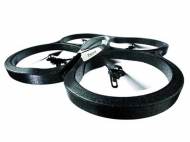RC flying with augmented reality – Parrot AR.Drone quadricopter
 Imagine you are the pilot of an aircraft that flies like a dragonfly, and with an on-board video camera, you see exactly what the pilot sees. Imagine no more because Parrot, a company that develops wireless devices for mobile phones, came up with AR.Drone – a remote controlled quadricopter. Unlike similar remote controlled flyers, these drones are controlled by networked iPhone and iPod Touch devices because they have utilized on-board Wi-Fi.
Imagine you are the pilot of an aircraft that flies like a dragonfly, and with an on-board video camera, you see exactly what the pilot sees. Imagine no more because Parrot, a company that develops wireless devices for mobile phones, came up with AR.Drone – a remote controlled quadricopter. Unlike similar remote controlled flyers, these drones are controlled by networked iPhone and iPod Touch devices because they have utilized on-board Wi-Fi.
The Wi-Fi has a respectable 50 meter range in open spaces, but the range is shorter in urban areas (around 20 meters) due to signals from other Wi-Fi networks and other urban obstructions. If the drone is out of its range, or if its battery runs out, it will simply stop and land to the ground. Even if it drops somehow, that shouldn’t represent a problem because it is built of carbon fibers and high resistance PA66 plastic. The Drone comes complete with two casings meant for indoor and outdoor use, and both are lightweight, resilient and come in a variety of designs.
The AR.Drone autopilot allows easy take-off and landing. After take-off, autopilot stabilizes the quadricopter at heaight of 50 centimeters (1.7 ft). When the pilot removes his fingers from the controller touch screen, the autopilot puts the AR.Drone in hover mode. The autopilot will also take command when the Wi-Fi connection is lost. It stabilizes the AR.Drone before a soft landing. If you receive a call while flying the quadricopter, the autopilot stabilizes it and lands after few seconds.
There drone has 2 onboard cameras one on its bottom (with 64° diagonal lens, CMOS sensor and video frequency of 60 fps) and the front wide angle camera (with 93° wide-angle diagonal lens camera, CMOS sensor, encoding and live streaming of images to iPhone/iPad and VGA resolution). The cameras also enable the AR.Drone software to incorporate Augmented Reality functions such as detecting other AR.Drone in flight, detecting and positioning markers on the ground or on the walls. Depending on the applications downloaded, it opens up a whole new world to users: they can take part in wild races in their own garden, or fight against aliens hidden in their living room.
It is also equipped with intertial guidance systems with MEMS (3 axis accelerometer, 2 axis gyrometer and 1 axis yaw precision gyrometer), ultrasound altmeter with range of 6 meters (19.7 feet) and EPP hull (reinforced plastic used in modern car bumpers) for in order to provide autopilot functions, altitude regulation and safety features such as the automatic propeller lock in the event of contact.
There are two available piloting modes Beginner and Ace/Expert, which change the number of controls required to maneuver. The development platform is all open source and there are around 450 developers who have already registered. Interestingly this also indicates that the range of controller platforms (currently limited to iPhone, iPad and iPod Touch) could easily and quickly expand to other smartphones.
Disappointingly, the battery life is only 12 minutes, and it requires a 90 minute recharge. However, folks from Parrot announced the spare batteries will be available on their website along with replacement parts for those who manage to break them. The AR.Drone is also a bit pricey but it offers many possibilities since the community could create many games for it. Let’s hope the folks from Parrot will make its price a bit more affordable.









author
The announced price for its official release on July 18th is around $300.
Exciting ideas, thanks for sharing them in this article.
Hey there, this is actually a great article. You receive my vote for this and I will bookmark this website right now.